Provider
From London to Berlin, Milan to Vienna: for about a decade now, increasing numbers of people are again living, working or studying in new timber buildings. And Amsterdam in no exception. Standing 73 metres high and featuring 21 floors, HAUT – as the project is called – is the tallest timber high-rise in the Netherlands. The word HAUT is not a reference to the French for “high” – although that would also be appropriate – but is in fact inspired by the Dutch word “hout”, meaning “wood”.
In February 2022, the apartments were handed over to their new owners. Thanks to floor-to-ceiling windows, the 50 luxurious flats and two penthouses with high ceilings and a floor area of up to 225 square metres are all flooded with light and offer incredible views over the Amstel river, the Stadshaven Amstelkwartier marina and the Somerlust park. For those who like to keep fit, the health & performance club “Great” is located on the ground floor. In the basement there is underground parking with charging stations for electric cars.
Grateful for the trust shown
The innovative, spectacular building was designed by Team V Architects. The construction firm J.P van Eesteren was responsible for the build. And another company at the heart of the project was Assmann Beraten + Planen GmbH, which has been part of the BKW Engineering network since 2017. Working closely together with timber construction firm Brüninghoff and the Austrian planning agency RWT+, Assmann was responsible for structural planning of the timber construction and engineering support at the construction site. “We are very grateful for the trust that the client placed in us,” says Andreas Wemmer, project manager in timber construction planning at Assmann. He’s pleased that his team, which included Henning Klattenhoff as technical lead for timber construction planning, had the chance to work successfully on a project like this. After all, there aren’t many projects around the world that compare with this one. “It does fill me with a bit of pride to have delivered substantial planning support for such a flagship project,” says Wemmer.
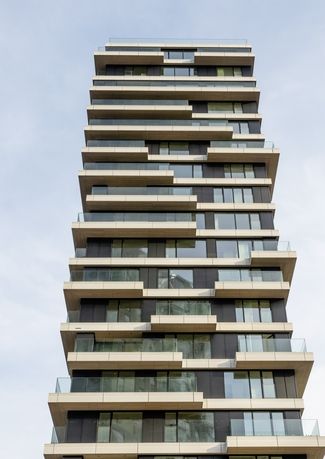
2,800 cubic metres of timber used
HAUT Amsterdam may be known as the “haute couture” building of the Dutch capital, but there is more to it than a handsome façade and great views. Only in the foundations, basement and core of the building was concrete or reinforced concrete used, while the supporting structure consists to a large extent of cross-laminated timber walls. The ceilings were made using a composite wood concrete construction. The wood used originates from sustainably managed European forests and stores around three million kilograms of carbon dioxide overall. This was also a requirement set by the city of Amsterdam. Sustainability factors ranked highly in the evaluation of the architectural competition for the project. Solid timber elements therefore took precedence over other construction materials. The result: HAUT consists of a total of 2,800 cubic metres of wood. That’s roughly the equivalent of the volume of an Olympic swimming pool.

«It does fill me with a bit of pride to have delivered substantial planning support for such a flagship project.»
Numerous challenges
Assmann’s tasks were manifold. “Together with a German timber building contractor we provided guidance to the design team and the clients early on in the launch phase of the project,” explains Wemmer. “After that the specialist timber construction planning department worked on behalf of the German timber building contractor Brüninghoff on the structural planning in work stages 4 and 5 – that is, approvals and detailed structural engineering – for the vertical components of the high-rise, the basement level and the steel roof.”
Andreas Wemmer tells of numerous challenges that a carbon-neutral timber hybrid high-rise of this kind poses for all involved. “The requirements on the robustness of the wooden structure, such as the failure of individual supporting elements with simultaneous prevention of an overall collapse of the supporting structure – these were not everyday tasks.” The interaction and communication between various technical planners across national borders – involving language barriers and deviations in standardisation – were also not always easy.
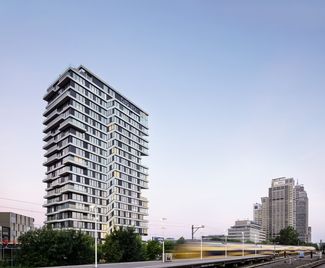
The planning also threw up countless questions: Would the lamination of the wood hold in the case of fire? How could air pockets in the mortar joints be assessed retrospectively? And what about the potential threat of the terrible woodworm? “Timber high-rise planning requires not only experience, but sometimes also courage and stamina,” says Wemmer. Assmann has demonstrated this stamina. The result is a new architectural icon in the Dutch metropolis that is Amsterdam.
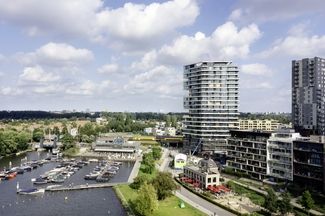
Buyers designed their own homes
In addition to the natural warmth that a wooden structure brings, it also offers a high level of pre-fabrication in the components as well as opportunities for personalisation. This allows the building to live up to its name, which is derived not only from the Dutch word “hout” (wood), but also from the fashion term “haute couture”. Those buying the apartments had access to a tailored “haute architecture”, enabling them to play an active role in designing their homes and make decisions on aspects including size, number of floors, layout, and the arrangement of balconies and terraces. The apparently random arrangement of self-supporting balconies, with their wooden ceilings and large projections at the sharp edges of the building, characterises the distinctive design of the new residential icon of Amsterdam. Without supporting façade elements, it was possible to create an open, transparent façade design. Within this, the floor-to-ceiling windows offer exceptional views over the Amstel between the Oud-Zuid and Watergraafsmeer neighbourhoods.
Facts & Figures: Hybrid timber high-rise HAUT
- Height: 73 metres, floors: 21, 52 apartments, GFA: 14,500 m2
- Start of construction: 2016, completion: 2021
- Client: Lingotto
- Design team: Team V, Arup Netherlands
- Main contractor: JP Van Eesteren
- Subcontractor for timber construction: Brüninghoff
- Consulting and timber construction planning: ASSMANN BERATEN + PLANEN GmbH, RWT+
- Awards: Shortlisted for WAF Awards 2018; 2018: International BREEAM Award
Our contribution to sustainability
 | With our actions, products and services, we are contributing to the sustainable development of society, the economy and the environment. BKW develops solutions for the design of sustainable infrastructures and living spaces. In doing so, it is committed to the UN’s Sustainable Development Goals. You can find out more about our approach to sustainability management here. |
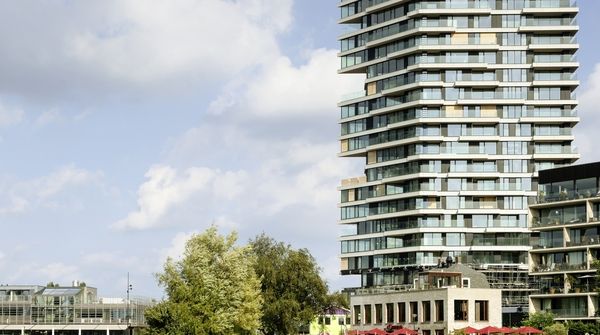
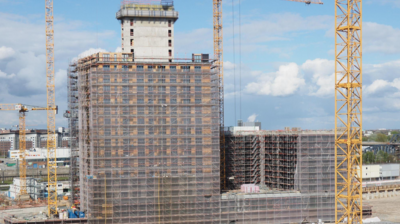
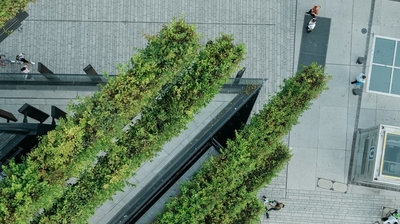




Comments